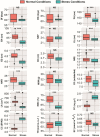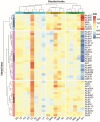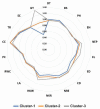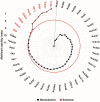Determination of morpho-physiological and yield traits of maize inbred lines (Zea mays L.) under optimal and drought stress conditions
- PMID: 35968146
- PMCID: PMC9366912
- DOI: 10.3389/fpls.2022.959203
Determination of morpho-physiological and yield traits of maize inbred lines (Zea mays L.) under optimal and drought stress conditions
Erratum in
-
Erratum: Determination of morpho-physiological and yield traits of maize inbred lines (Zea mays L.) under optimal and drought stress conditions.Front Plant Sci. 2022 Nov 15;13:1069938. doi: 10.3389/fpls.2022.1069938. eCollection 2022. Front Plant Sci. 2022. PMID: 36466295 Free PMC article.
Abstract
Globally, climate change could hinder future food security that concurrently implies the importance of investigating drought stress and genotype screening under stressed environments. Hence, the current study was performed to screen 45 diverse maize inbred lines for 18 studied traits comprising phenological, physiological, morphological, and yield characters under optimum and water stress conditions for two successive growing seasons (2018 and 2019). The results showed that growing seasons and water regimes significantly influenced (p < 0.01) most of the studied traits, while inbred lines had a significant effect (p < 0.01) on all of the studied traits. The findings also showed a significant increase in all studied characters under normal conditions compared to drought conditions, except chlorophyll content, transpiration rate, and proline content which exhibited higher levels under water stress conditions. Furthermore, the results of the principal component analysis indicated a notable distinction between the performance of the 45 maize inbred lines under normal and drought conditions. In terms of grain yield, the drought tolerance index (DTI) showed that Nub60 (1.56), followed by Nub32 (1.46), Nub66 (1.45), and GZ603 (1.44) were the highest drought-tolerant inbred lines, whereas Nub46 (0.38) was the lowest drought-tolerant inbred line. These drought-tolerant inbred lines were able to maintain a relatively high grain yield under normal and stress conditions, whereas those drought-sensitive inbred lines showed a decline in grain yield when exposed to drought conditions. The hierarchical clustering analysis based on DTI classified the forty-five maize inbred lines and eighteen measured traits into three column- and row-clusters, as inbred lines in cluster-3 followed by those in cluster-2 exhibited greater drought tolerance in most of the studied traits. Utilizing the multi-trait stability index (MTSI) criterion in this study identified nine inbred lines, including GZ603, as stable genotypes in terms of the eighteen studied traits across four environments. The findings of the current investigation motivate plant breeders to explore the genetic potential of the current maize germplasm, especially in water-stressed environments.
Keywords: drought tolerance index (DTI); inbred lines; maize; morpho-physiological; principal component analysis; yield traits.
Copyright © 2022 Balbaa, Osman, Kandil, Javed, Lamlom, Ali, Kalaji, Wróbel, Telesiñski, Brysiewicz, Ghareeb, Abdelsalam and Abdelghany.
Conflict of interest statement
The authors declare that the research was conducted in the absence of any commercial or financial relationships that could be construed as a potential conflict of interest.
Figures






Similar articles
-
Genetic Potential of Newly Developed Maize Hybrids under Different Water-Availability Conditions in an Arid Environment.Life (Basel). 2024 Mar 29;14(4):453. doi: 10.3390/life14040453. Life (Basel). 2024. PMID: 38672723 Free PMC article.
-
Genetic Potential and Inheritance Patterns of Physiological, Agronomic and Quality Traits in Bread Wheat under Normal and Water Deficit Conditions.Plants (Basel). 2022 Mar 31;11(7):952. doi: 10.3390/plants11070952. Plants (Basel). 2022. PMID: 35406932 Free PMC article.
-
Selection of Drought Tolerant Maize Hybrids Using Path Coefficient Analysis and Selection Index.Pak J Biol Sci. 2017;20(3):132-139. doi: 10.3923/pjbs.2017.132.139. Pak J Biol Sci. 2017. PMID: 29023004
-
Approaches and progress in breeding drought-tolerant maize hybrids for tropical lowlands in west and central Africa.Plant Genome. 2024 Jun;17(2):e20437. doi: 10.1002/tpg2.20437. Epub 2024 Feb 20. Plant Genome. 2024. PMID: 38379199 Review.
-
Securing maize reproductive success under drought stress by harnessing CO2 fertilization for greater productivity.Front Plant Sci. 2023 Oct 4;14:1221095. doi: 10.3389/fpls.2023.1221095. eCollection 2023. Front Plant Sci. 2023. PMID: 37860252 Free PMC article. Review.
Cited by
-
Investigation of the impact of dual inoculations of arbuscular mycorrhizal fungi and plant growth-promoting rhizobacteria on drought tolerance of maize grown in a compost-amended field under Mediterranean conditions.Front Microbiol. 2024 Oct 9;15:1432637. doi: 10.3389/fmicb.2024.1432637. eCollection 2024. Front Microbiol. 2024. PMID: 39473847 Free PMC article.
-
Determination of Morpho-Physiological Traits for Assessing Drought Tolerance in Sugarcane.Plants (Basel). 2024 Apr 11;13(8):1072. doi: 10.3390/plants13081072. Plants (Basel). 2024. PMID: 38674481 Free PMC article.
-
Biochemical and yield response of spring wheat to drought stress through gibberellic and abscisic acids.BMC Plant Biol. 2025 Jan 2;25(1):5. doi: 10.1186/s12870-024-05879-8. BMC Plant Biol. 2025. PMID: 39748257 Free PMC article.
-
Efficacy of Carbon Nanodots and Manganese Ferrite (MnFe2O4) Nanoparticles in Stimulating Growth and Antioxidant Activity in Drought-Stressed Maize Inbred Lines.Plants (Basel). 2023 Aug 11;12(16):2922. doi: 10.3390/plants12162922. Plants (Basel). 2023. PMID: 37631134 Free PMC article.
-
Evaluation of yield attributes and bioactive phytochemicals of twenty amaranth genotypes of Bengal floodplain.Heliyon. 2023 Aug 30;9(9):e19644. doi: 10.1016/j.heliyon.2023.e19644. eCollection 2023 Sep. Heliyon. 2023. PMID: 37809463 Free PMC article.
References
-
- Abdelghany A. M., Zhang S., Azam M., Shaibu A. S., Feng Y., Qi J., et al. (2021). Exploring the phenotypic stability of soybean seed compositions using multi-trait stability index approach. J. Agronomy 9:23. 10.3390/agronomy11112200 - DOI
-
- Adebayo M., Menkir A., Blay E., Gracen V., Danquah E., Hearne S. (2014). Genetic analysis of drought tolerance in adapted× exotic crosses of maize inbred lines under managed stress conditions. Euphytica 196 261–270. 10.1007/s10681-013-1029-5 - DOI
-
- Afzal I., Imran S., Javed T., Basra S. M. A. (2020). Evaluating the integrative response of moringa leaf extract with synthetic growth promoting substances in maize under early spring conditions. South Afr. J. Bot. 132 378–387. 10.1016/j.sajb.2020.04.025 - DOI
LinkOut - more resources
Full Text Sources

